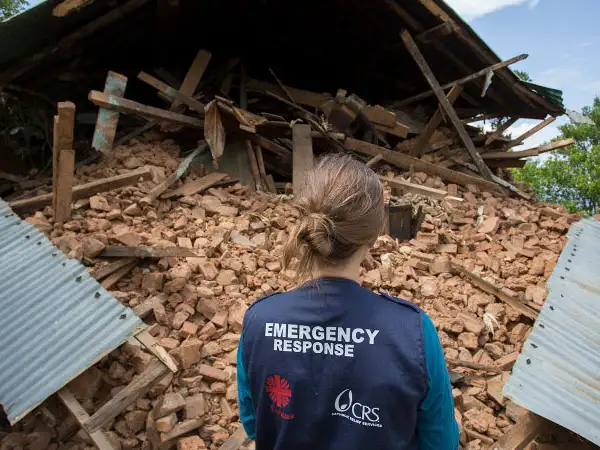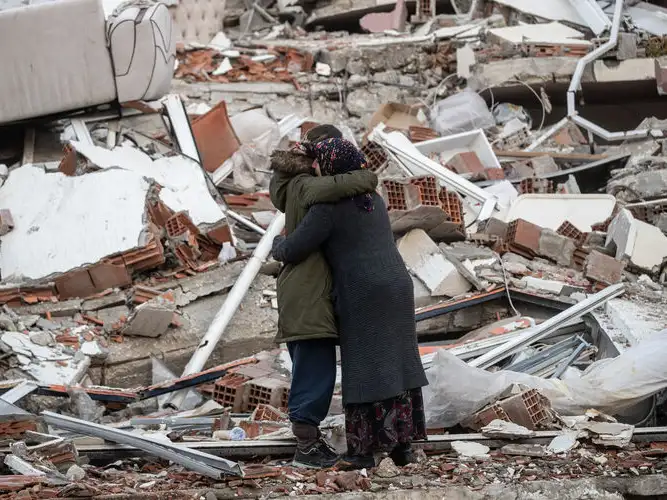

CAFOD partners delivered aid to some of the worst hit districts in Nepal following the 2015 earthquakes
CAFOD answers your questions about the earthquakes which hit Nepal on 25 April and 12 May 2015.
What happened?
On Saturday 25 April 2015 a massive 7.8 magnitude earthquake struck Nepal. The capital Kathmandu was badly damaged, while in rural areas near the epicentre 90% of people lost their homes and livestock, and were left with no sources of food. This was the worst earthquake to hit Nepal for 81 years. Millions of people were affected, at least 8,700 were killed, and more than half a million homes were destroyed.
Just over two weeks later, on Tuesday 12 May, a second 7.3 magnitude earthquake hit Nepal, adding to the destruction. In the months since, the monsoon rains and harsh winters in the north have made life even more challenging for many families.
CAFOD’s Church partners have been on the front line of the emergency response, providing immediate and longer term aid to hundreds of thousands of people.
What were the humanitarian needs?
The two major earthquakes had a catastrophic impact on the lives of millions of people. Even before the earthquakes, 25 per cent of the population of Nepal were living in extreme poverty, and many of those affected lost their homes, their possessions and their means of making a living in the earthquakes.
In the first few months following the earthquakes, affected families needed food, emergency shelter and essential household goods. People also needed clean water, sanitation and support with hygiene in order to prevent the spread of disease. In the months and years that followed people needed help rebuilding their homes and restoring their means of earning an income.
The main need was for shelter support, and those living in high altitude areas were particularly vulnerable over the winter.
Who are CAFOD’s partners in Nepal?
We have been working with Caritas Nepal, which has extensive networks across the country, as well as with Catholic Relief Services, Caritas Switzerland and Cordaid from the Caritas network of Catholic agencies.
We have also been working with SAPPROS Nepal, Parivartan PATRA and Community Action Nepal, who have been supporting communities in Nepal for many years.
How has CAFOD responded to the Nepal earthquakes?
Since the earthquakes struck, CAFOD’s partners have supported over 100,000 people, helping them through the immediate aftermath of the earthquake, through harsh winters, and then on to start rebuilding their lives.
Since reconstruction began, we have supported many thousands of families by rebuilding schools and homes, repairing damaged water systems, providing training to people from affected communities, so they can earn a living again and build safer homes that can withstand earthquakes.
Our work is possible because of the generosity of Catholics in England and Wales, who have donated more than £3.9 million to our Nepal Earthquake appeal. The Disasters Emergency Committee (DEC) – a coalition of leading UK aid agencies, of which CAFOD is a part – also launched a joint appeal that has raised more than £85 million.
Immediate life-saving relief
CAFOD and our partners began delivering aid within hours of the first earthquake, and continued to work hard to provide aid to families who had their lives torn apart. The Caritas network of Catholic aid agencies provided food, shelter kits and emergency supplies to more than 350,000 people across 15 earthquake-affected districts in the first few months. CAFOD’s team on the ground provided technical expertise around water, sanitation and hygiene, and in the protection of children and vulnerable adults, as well as management support to our partners.
Over the first winter, CAFOD’s partners Catholic Relief Services and Caritas Nepal delivered winterisation support – including blankets, tarpaulins, foam mats, and grants for clothing and fuel – to over 37,000 people, to help them through the colder months. CRS and Caritas Nepal also provided cash grants to help very vulnerable families in Gorkha District to buy crucial items like clothes and food.
Re-building schools and houses
In Sindhupalchowk District, where the earthquake led to 89 per cent of school classrooms being destroyed or made unsafe, our partner Caritas Switzerland has been rebuilding 34 schools and training teachers and students on how to be safer in disasters. Community Action Nepal has been doing similar work in the remote area of Goankarkha. With CAFOD support, 7 new earthquake-resilient schools have been completed and will soon be handed over to the local communities.
Our partners have been working with over 10,000 families to rebuild safe homes, through supporting them to access grants and plan their homes, training local masons in building techniques to withstand earthquakes, and educating communities on safe reconstruction.
Water, building of latrines and hygiene promotion
In Rasuwa District, our partner Cordaid provided clean water, latrines and relief items to around 2,500 people living in temporary camps after their villages were destroyed.
CAFOD partner Parivatran PATRA rebuilt water sources damaged by the earthquake, and provided information and guidance to more than 6,000 people on the importance of maintaining good hygiene practices in and around their homes. CAFOD’s partners also provided safe drinking water for pupils and teachers in 19 earthquake-affected schools.
Restoring people’s livelihoods
Over the last three years CAFOD has supported its local partners to help people to recover from their losses and restore their source of income. CAFOD partner SAPPROS has helped 1350 women and men with different income-generating activities including fish farming, seasonal vegetable growing, and goats and poultry rearing.
How have you coordinated your response to the Nepal Earthquakes with others?
As a member of Caritas International – the second largest humanitarian network in the world – we coordinated closely with other Catholic agencies working in Nepal to ensure that our response is as efficient and effective as possible. Caritas agencies are working with Caritas Nepal, which has an existing network of staff and volunteers in some of the hardest to reach areas of the country.
CAFOD and its partners have also worked with the Nepalese government, UN agencies and other national and international NGOs in Nepal to ensure a well-coordinated response. As part of the Disasters Emergency Committee (DEC), we worked together with twelve other major British aid agencies to ensure that we were not duplicating our efforts.
Are earthquakes common in Nepal?
Earthquakes are common in or near the Himalayas, where the Indian tectonic plate pushes five centimetres north a year, coming up against the Eurasian plate. In Nepal the last quake of similar magnitude was in 1934. 70 or 80 years appears typical between big earthquakes.
Over five million people live in and around Kathmandu, and seismologists have long feared a major earthquake striking the sprawling city. Although the government and aid agencies had worked hard to prepare for an earthquake, Nepal is one of the poorest countries in the world and understandably struggled to cope with a disaster on this scale.

Join us today with a monthly donation
Helping in emergencies needs all of us. Before, during and after a crisis, our local experts are working in their own communities to help families prepare, survive and rebuild.
With more emergencies than ever, there has never been a greater need for us to put our faith into action, together.
Please join us today with a monthly donation to our emergency response work. You can also sign up to receive prayer texts for when there is an emergency.

